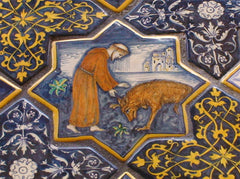Saint Francis of Assisi
Visiting Assisi in Umbria, Italy, one cannot miss people’s adoration for Saint Francis, Italy’s patron saint.

St. Francis of Assisi is known for his ministry to the poor and underprivileged, his care for nature and animals, and founding the Franciscan order. The son of an affluent cloth merchant, Francis lived in wealth and ease until God used a meeting with a leper to change his heart.

After Francis made a stand before his father for Jesus and poverty’s sake in 1207, he fled to stay with friends in Gubbio where he knew he would be safe from his father’s wrath. During his three months there he cared for the poor, the outcasts and the lepers.

Francis considered all nature as the mirror of God. He called all creatures his “brothers” and “sisters,” and, in the most endearing stories about him, preached to the birds and persuaded a wolf to stop attacking the people of the town of Gubbio and their livestock if the townspeople agreed to feed the wolf.

Probably no one in history has set out as seriously as Francis to imitate the life of Christ and to carry out so literally Christ’s work in Christ’s own way. He preached wherever he went and his charismatic personality and radical message soon attracted followers. By 1209 he had 12 disciples and his order was recognised by Pope Innocent III.

The Basilica San Francesco dominates the lower end of Assisi and is a grand tribute to this humble man of God.

Visit his tomb under the Lower Basilica and then gaze in awe at the beautiful artworks in both the lower and upper churches, illustrating the story of his life.

There are many other sites in the area significant to St. Francis. If you have time, we recommend visiting Rivotorto to the east of Assisi. Inside the church is a replica of the rough huts where Francis and his first friars friends lived in the church and gorgeous stained glass windows depict significant moments in his life.

Outside the church is a charming statue of Francis, arms uplifted to welcome a flock of birds while children dance around him.

Another fascinating place is the Basilica of Santa Maria degli Angeli in the valley below Assisi.

It’s grandiose size and decorations (it is the seventh largest Christian church in Italy) are at odds with the poverty and simplicity preached by Saint Francis in the tiny Porziuncola Chapel, which now stands under the dome of the church. The chapel was one of the churches restored by Saint Francis and given to him to be the mother house of his order.

Our favourite Francis ‘place’ though is Eremo delle Carceri, a stone hermitage on the mountain above Assisi. He and his followers would spend time in the caves praying and meditating on God’s word. If you visit it early, before the hordes of pilgrims and tourists descend, it has a deep tranquility and simple beauty.

Francis was made a saint two years after his death on July 16, 1228 and his life of devotion and service still resonates with millions of followers around the world.
PEACE PRAYER
While often attributed to St. Francis of Assisi, the 'Peace Prayer' wasn’t written by the saint, but reflects the way he lived his life. It is a beautiful prayer so we decided to include it...
Lord, make me an instrument of your peace:
where there is hatred, let me sow love;
where there is injury, pardon;
where there is doubt, faith;
where there is despair, hope;
where there is darkness, light;
where there is sadness, joy.
O divine Master, grant that I may not so much seek
to be consoled as to console,
to be understood as to understand,
to be loved as to love.
For it is in giving that we receive,
it is in pardoning that we are pardoned,
and it is in dying that we are born to eternal life.
Amen.
